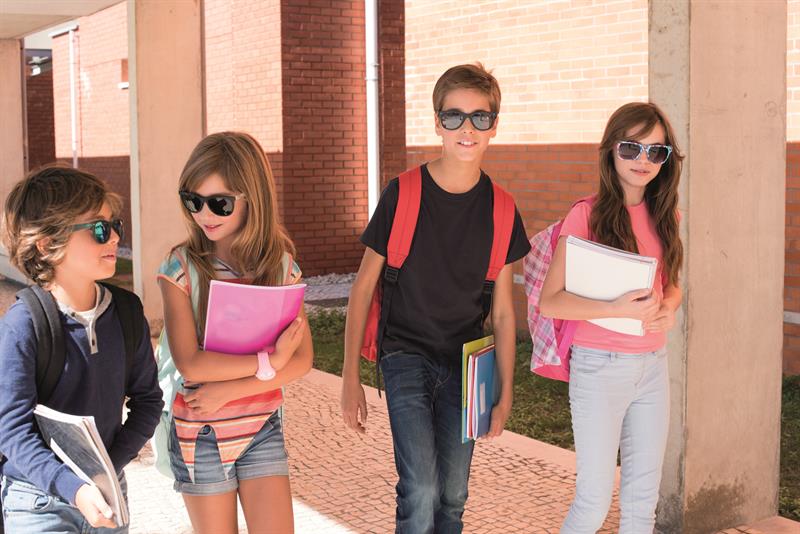June 27 marked the Vision Council’s national sunglasses day. Last year’s awareness day proved to be a big success and generated more than one billion social and broadcast media impressions, trended highly on twitter and stimulated conversations regarding UV protection and eye health.
This year’s day, falling on a particularly sunny Thursday in the UK, also caused quite a stir. An initiative launched by children’s eyewear brand Monkey Monkey asked whether school uniforms should include sunglasses to protect children’s eyes from the dangers of UV light.
Monkey Monkey commissioned a study into parents’ understanding of the dangers posed by UV radiation and their views on the place of UV protection in schools. The good-sized study of 1,000 parents with children aged four to 12 revealed that more than half, 54%, wanted sunglasses to become an official part of school uniform.
Shockingly, 17% claimed there was not enough sun in the UK to ever warrant sunglasses, while almost a quarter said their child’s school did not allow sunglasses and 40% were unsure as to whether their school even had a policy on the issue.
A Monkey Monkey spokesperson said: ‘Parents are consistently telling us that their children are more likely to wear sunglasses on holiday or to leisure activities than at school.
‘We just want parents to be aware that the midday and afternoon sun can be equally strong in the school playground, on the school sports field, or on the walk home from school, as it is on the beach.’
It has long been understood that, according to the World Health Organisation (WHO), ‘80% of a person’s lifetime exposure to UV is received before the age of 18’ and that ‘children require special protection as they are at a higher risk of suffering damage from exposure to UV radiation than adults’.
Furthermore, because their eyes are not yet fully developed, children have less natural protection from the harmful effects of UV light, their pupils are larger and let in more UV light, and their crystalline lens is more transparent and less efficient at filtering out UV.
Nonetheless, uniform rules in the UK are set by the governing body of individual schools and no national blanket policy exists. A Department for Education (DfE) spokesperson told Optician it was up to ‘school leaders to make decisions about school uniform as they are best placed to ensure these policies meet the needs of their pupils’, but that, ‘school uniform costs should not be a barrier for any pupil attending or applying to a school of their choice.’
‘We have already made clear to schools – in written guidance – that when setting uniform policies, they should keep costs to a minimum and be mindful that they are affordable for everyone,’ they added.
Thoughts from government
Given that school uniform policy is set independently, neither the government nor any other organisation can impose rules. However, there are some factors for school boards to consider when deciding about eyewear in school.
 Should schools insist on UV protective sunglasses for their children?
Should schools insist on UV protective sunglasses for their children?
The Health and Safety Executive (HSE), a UK government agency responsible for the encouragement, regulation and enforcement of workplace health, safety and welfare, said ‘this is not a matter that relates to health and safety at work legislation’.
‘The real issue here is about teaching children how to take sensible precautions on a long-term public health risk which they will need to deal with throughout their lives, not just at school.’
Pressed about when and where children should be wearing glasses in school, its spokesperson said: ‘It’s unlikely UV would be a significant problem within the classroom. Risks outside would vary according to the site but would be similar to those in everyday life and could be managed with sensible precautions such as provision of some shaded outside areas, hats and timing of lessons, as well as sunglasses.
‘Voluntary use and explanation of risk benefits of wearing sunglasses may be more appropriate than blanket rules.’
But would there need to be a certain type of sunglass, one which does not discriminate in terms of affordability, that is approved for school use? HSE said: ‘Individual pupils are likely to be advised on appropriate eye lenses for both vision and UV protection during routine and statutory health checks. Any UV eye protection would need to be compatible with other medical devices children already use.
‘Cost may be prohibitive to some families and it is therefore unlikely schools would insist on sunglasses without departmental guidance.’
The Department for Education has not called for this and has said it ‘trusts school leaders’ to make the right choice.
A healthcare perspective
With government agencies reticent, what do health authorities say on the topic? The WHO has reminded us that, in an age of climate change and ozone depletion, ‘levels of UV radiation on Earth will aggravate UV effects on the human skin, eyes and immune system’, and that, ‘children are at especially high risk of suffering damage from exposure to UV radiation.’
It said that children should be equipped with protective clothing, which included sunglasses, to prevent UV damage to the eyes that can ‘lead to inflammations of the cornea and the conjunctiva in the eye, and causes or accelerates cataract development.’
National Institute for Health and Care Excellence (NICE) guidance addressed at risk groups, how to raise awareness about the dangers of UV exposure and local strategies for protecting yourself against UV damage.
It stated: ‘Protection from the sun can be achieved by covering up with suitable clothing, seeking shade and applying sunscreen.’
For NICE, suitable clothing meant a hat that shades the head and neck, long-sleeved tops and trousers or skirts that do not allow light to penetrate – all of which could be found in a typical school uniform.
‘It also includes sunglasses with wraparound lenses or wide arms (to provide side protection) that have the CE Mark – an indication they meet the relevant European Standard,’ said NICE.
Finally, although NICE’s guidance is predominately in reference to UV exposure and skin damage, it has argued that ‘managers and health, public health and social care practitioners who have a duty of care for others (for example […] in education) could develop a policy to address the risks and benefits of sunlight exposure.’
 Daniel Hardiman-McCartney
Daniel Hardiman-McCartney
It advises practitioners to encourage children to adopt an active lifestyle – something that is widely recognised to help prevent the onset of myopia – but acknowledges that the exact mechanism for this protection is not fully understood yet.
Hardiman-McCartney continued: ‘Bright light causes discomfort, hence the recommendation of sunglasses, but optometrists’ advice should balance these seemingly conflicting needs where a child is at risk of myopia, and this is why a one-size-fits-all policy on sunglass use in schools may be problematic. It would also be very important to ensure the correct fit of the sunglasses frame and appropriate colour and level of filter used for every child.
‘Although I would welcome greater support and encouragement for children to wear sunglasses when playing outside at school or nursery on bright and high UV index days, children would be best served by using sunglasses (at any time) recommended, fitted and provided by their own optometrist or from a reputable source.’
It seems as though we have reached a bit of an impasse. Monkey Monkey’s initiative and research has posed some interesting questions to the optical industry and school system, but decentralised policy and reservations about the appropriateness of mass-distributed eyewear persist. Whether or not the changes come is still to be seen, but the question has been asked and the conversation has begun.
